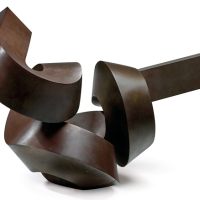36. CLEMENT MEADMORE

There is cool uniformity and geometric logic to the sculptures of Clement Meadmore. They resonate with architecture as they do with the viewer. It is in relation to their scale that we acknowledge them. Recognition is at once a gestalt; we consider the whole sculpture, but as we move about our perception changes as we take account of mass, balance, and weight.
Clement Meadmore settled permanently in New York in 1963. He entered a milleu that was accommodating, and he saw in the studios he visited an established style of minimal painting and sculpture. New York made the image of modern art their own and fashioned each new movement in the Post-War era. Meadmores timing was prescient and having met artists Mark Rothko (1903-1970), Barnett Newman (1905-1970), and Donald Judd (1928-1994), amongst others, he sensed a way forward.
Meadmore took his sculpture from the plinth to the floor to see shape differently. His forms became solid cubes which touched upon industrial and mechanical processes. With each change in form came a liberation and, in turn, a dialogue that liberated Meadmore from the pictorial aspects of his previous sculpture.
The critic Clement Greenberg by the early 1960s had identified a new type of sculpture:
It is its physical independence, above all, that contributes to the new sculptures status as the representative visual art of modernism. A work of sculpture, unlike a building, does not have to carry more than its own weight, nor does it have to be on something else, like a picture; it exists for and by itself literally as well as conceptually. And in this self-sufficiency of sculpture, wherein every conceivable as well as perceptible element belongs together to the work of art, the positivist aspect of the modernist aesthetic finds itself most fully realized.1
By the late 1960s, Meadmores sculptures had evolved from early cuboid shapes into curvilinear forms. It was apparent that he could go further into a lyrical dimension in which we now see the beginnings of a mature and signature style. The curve and the ribbon are the distinct aspects of Meadmores sculpture, as is the essential columnar shape.
Riff 1996 (Pt. Leo Estate Sculpture Park Collection, Victoria) is seen in painted steel, placed outdoors. It is like Warm Valley in formal orientation and winds from a central access to a lateral spread. The horizontal axis is in parallel with the ground and the wings of the sculpture run left and right, each side in different length from the other. Outdoor steel sculptures, such as Riff, hold their form and push into space convincingly. The title so appositely describes the feel if not the intention of the sculpture.2
Wallflower 1987 (Private collection), by contrast, is the equivalent size to Warm Valley. It is in bronze with a warm patination. An obdurate form, but one with great integrity, is cleverly split, projecting into the viewers space. It appears both an architectural conceit but is also emblematic in the way a logo is. This is refined territory and the better for casting in bronze.
How fortunate then to include Clement Meadmores Warm Valley 1994 in our sale. It is a size not seen at auction in Australia. It has appeared at the smaller scale with great success, a testament to the classic nature of the sculpture and the ribbon like openness of the form. The arms are extensive in their lateral reach, emphasising the horizontal nature of ground on which we stand. This basis in geometry is what gives the sculpture its liberation to ribbon into shape. Our eye seeks the middle and negative space, to return, travelling left to right. This is a visual and tactile description but in analogy, when we think of sky and warm winds, the experience becomes something other, an image, but in parallel to the sculptural integrity of Warm Valley.
FOOTNOTES
1. Greenberg, C., The New Sculpture in Art and Culture: Critical Essays, Beacon Press, Boston, 1989, p.145
2. It is a compliment to Clement Meadmore that his sculptures fit so well to an indoor setting. They achieve a quiet repose, and their smooth patination attracts the eye. It is a further credit to the design that larger Meadmore sculptures settle as happily in the greater world. Sighting sculptures requires consideration of sight lines and the effect of light on forms, issues that sculptors and architects commonly consider.
Brett Ballard